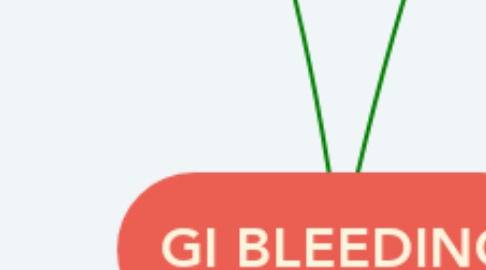
1. TYPE
1.1. UPPER
1.1.1. Esophageal - Duodenum
1.1.1.1. Duodenal Ulcer
1.1.1.2. Gastric Ulcer
1.1.1.3. Varices
1.1.1.4. Mallory Weiss Syndrome
1.1.1.5. Esophageal/Gastric Cancer
1.2. LOWER
1.2.1. Duodenum - Rectum
1.2.1.1. Hemorrhoids
1.2.1.2. Diverticulosis
1.2.1.3. CA Colon/Rectum
2. NURSING CARE
2.1. 1.Hypovolemic Shock
2.1.1. IV Fluid
2.1.2. Blood Component
2.1.3. Follow Lab CBC Coagulation DTX
2.2. 2.Risk for Hypoxia
2.2.1. Oxygen Support
2.3. 3.Recurrent Patient
2.3.1. Introduce self-care practices
3. MEDICATION
3.1. Antacids
3.2. H2 Receptor Antagonist
3.3. Sucralfate
3.4. Proton Pump Inhibitors
3.5. Somastatin
4. SENGSTAKEN BLAKEMORE TUBE
5. SIGHS & SYMPTOMS
5.1. UPPER
5.1.1. 1.Hematemsis
5.1.2. 2.Coffee Ground
5.1.3. 3.Melena
5.1.4. 4.Shock
5.2. LOWER
5.2.1. 1.Hematochezia
5.2.2. 2.Shock
6. TREATMENT
6.1. UPPER
6.1.1. Upper Gastrointestinal Study
6.1.2. Endoscope
6.2. LOWER
6.2.1. Proctosigmoidoscope
6.2.2. Colonoscope
6.2.3. Barium Enema
6.3. UPPER&LOWER
6.3.1. Gastrointestinal Follow Through
6.4. OTHER
6.4.1. Routine ETT Before SB Tube
6.4.2. Inflate Gastric Balloon in 2 Steps 50cc - X-Ray - 200-250cc
6.4.3. Inflate Esophageal balloon <45 mmHg
6.4.3.1. Avoid necrosis (<6Hrs.)
6.4.4. 1-kg Traction compress GE Jungtion -- Reduce EV blood floe
